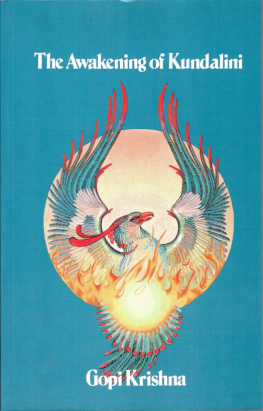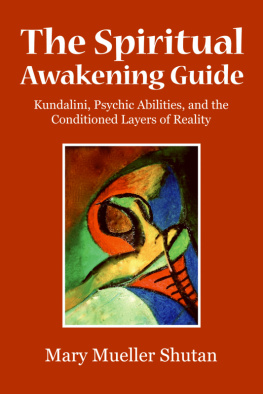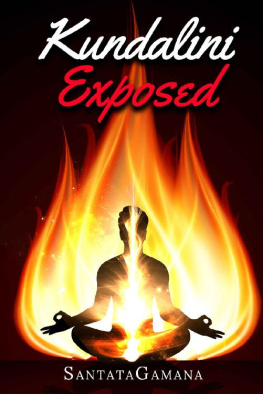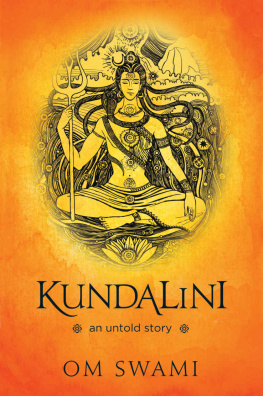This is the story of my journey from separation, to reconnection with the universe. It is unusual in that there are two interlocking streams within the process, kundalini awakening and shamanic awakening. Although these processes are natural and the most ancient forms of spiritual phenomena experienced by human beings, neither are accepted or acknowledged by western science or culture. Anthropology has viewed shamans as schizophrenics and scholars have viewed kundalini, as described in the ancient yogic texts, as little more than a beautiful metaphor. Yet these are very real processes, not confined to man-made parameters and may happen to any of us, irrespective of race or cultural background.
My journey began with yoga and that tradition holds that we pick up spiritually in the next life, from the point we reached in the previous one. As a child I was drawn into advanced yogic practices. After a break of many years I returned to yoga in adult life, receiving the great gift of a kundalini awakening. After some years within the kundalini awakening process I began to realise that a great deal of the phenomena I was experiencing fell firmly within the realms of shamanism, as well as yoga. This was in fact first noticed by my wife Michle, who strongly intuited that there was a shamanic element to what was happening to me. Initially, I firmly rejected this possibility. I didnt really know what shamanism was, I had a prejudiced opinion based on uneducated preconceptions and had absolutely no desire or ambition in that direction. Eventually, the shamanic nature of the phenomena I was experiencing became so strong that I began to seriously consider that she may have been right all along. Searching for answers I began to come across accounts both old and new, which closely corroborated my experiences as being shamanic initiations.
Awareness of kundalini awakening has increased due to the spreading of yoga in the west and the rise of the Internet, but shamanic awakenings still remain largely a mystery, even in spiritual circles. As with kundalini awakenings, each individual shamanic awakening will be different and Im not suggesting that what I relate in the narrative is the only way.
What is described here is a shamanic path of consciousness, a sort of yoga of shamanism. I term what I have experienced, a shamanic kundalini awakening. A shamanic enlightenment process, where the universe expresses itself primarily through the consciousnesses of animals, trees, plants and stones. An experiential animism based in the direct revelation, that what we call god is in nature and that in spite of everything we have done and are doing to the planet, nature is still willing to talk to us.
This is not a how to book, there are numerous others out there offering practical advice concerning kundalini and shamanism. Nor is this book connected to any commercial spiritual organisation, there are no courses attached, it promotes no systems, you wont find workshops with me, advertised at the back. I make no claims to be a yogi, shaman, guru or spiritual teacher, this is simply a sharing of a deeply personal on-going spiritual awakening. I share purely in the hope that those experiencing similar phenomena might gain something from my own account and know they are not alone.
I dedicate this book to Michle, who accepted without question the validity of the spiritual experiences I describe and fully supported the on-going process of transformation they initiated. It is a rare soul that can do this.
Thanks also, to Marjolaine and imhn, for their support and understanding.
Special thanks to
Susan Ferguson, Dawn Dancing Otter, Josephine Fire Lame Deer and the late Martin A. Egan.
I used to think it all began the night I dreamed of the goddess Isis. In the dream I was walking the land around my house; there are thick, drystone walls everywhere and hidden inside one of these I found a tiny statue of Isis. It was pure white, very simple in design and beautiful. I brought it back to the house where a huge vat of water was waiting. I placed it in the water and Isis grew to full size and floated to the top. This dream felt so real that the next day I actually went looking for the statue. I didn't find it but it may well be there. Here, in the south west of France, in the land of Cathars and Templars, the black Madonnas are still to be seen and many believe that originally they were representations of this Egyptian goddess of rebirth. The next night, I again dreamed of a goddess. This time I saw a beautiful woman standing in a doorway. She was dressed in a hooded velvet cloak of the most stunning blue. Having been raised a Roman Catholic I sensed a Marian resonance from her. The third night, I had a shamanic dream. This time I was in a bookshop and stretched across its length, was a colossal anaconda. At the head of the snake was a jaguar, the two animals were engaged in a struggle. The next day, after this holy trinity of dreams, kundalini came and life was never the same again.
There is a beautiful word in the Gaelic language, 'cumha' (pronounced coo-ah). In Scottish Gaelic it denotes a lament and is used as a prefix in many of the ancient harp and pipes tunes written to honour the deaths of notable individuals such as clan chieftains. In Irish the meaning is subtler, rather than death, a sense of separation is implied. A Gaelic scholar once described it to me in the following way;
when the immigrants sailed for America leaving behind forever their families and the land of their birth, this was cumha. When the mare is parted from her foal, this is cumha.
I found myself, like so many in the western world today, in a state of cumha. Separated from nature and disconnected from source. I anesthetized myself with alcohol and told my ego endless stories. It became clear to me that I was lost. This is the story of my journey home, from cumha, to reconnection.
I had in fact been sensing cumha since childhood. Although I was born in England, my father was Irish and that was our primary cultural influence. We were Irish Roman Catholics in a protestant country and it was quite clear that home was somewhere else. Considering that the English saw me as Irish, and that the Irish saw me as English, I felt myself to be, like the shaman, between worlds from the earliest time.
At the tender age of nine I was introduced to the practice of yoga, a very strange world, which seemed to me, to be completely normal. Every few weeks, with some family friends, I would attend a small yoga retreat centre. Here we did a traditional yoga based on the teaching of an obscure swami. This yoga was quite different from the sanitised commercial versions that predominate today in the West and some of the practices, particularly the yogic purifications, were very advanced. Of these, sutra neti was considered the most important. I was strongly encouraged to do this because I suffered from asthma and chronic rhinitis. Sutra neti involves pushing a rubber catheter up your nostril and through the nasal passage until it emerges at the back of the throat. It is then pulled out with the fingers so that one end is sticking out of the nose and the other the mouth. The nasal passage is then cleared and massaged by pulling the tube back and forth.
To learn this, an ancient yogi took me into a small bathroom. We sat in front of the mirror and I inserted the tube into my nostril. This involved a great deal of sneezing and watering of the eyes until eventually I managed to get the tube to exit at the back of my throat. The next bit is tricky, you have to grip the tube behind the uvula with your first and middle fingers and pull it out of your mouth. You must not pull too much as a length of tube must remain extending out of the nostril and there is a huge gag reflex. I failed miserably at this and eventually the yogi did it for me. I soon became very proficient at sutra neti performing it every day for about three years. Its benefits extend far beyond merely clearing out the nasal passages. Swatramana described the practice of sutra neti in the second chapter of the Hatha Yoga Pradapika where it is called the Neti Karma. He says it is the cleaner of the brain and giver of divine sight.








